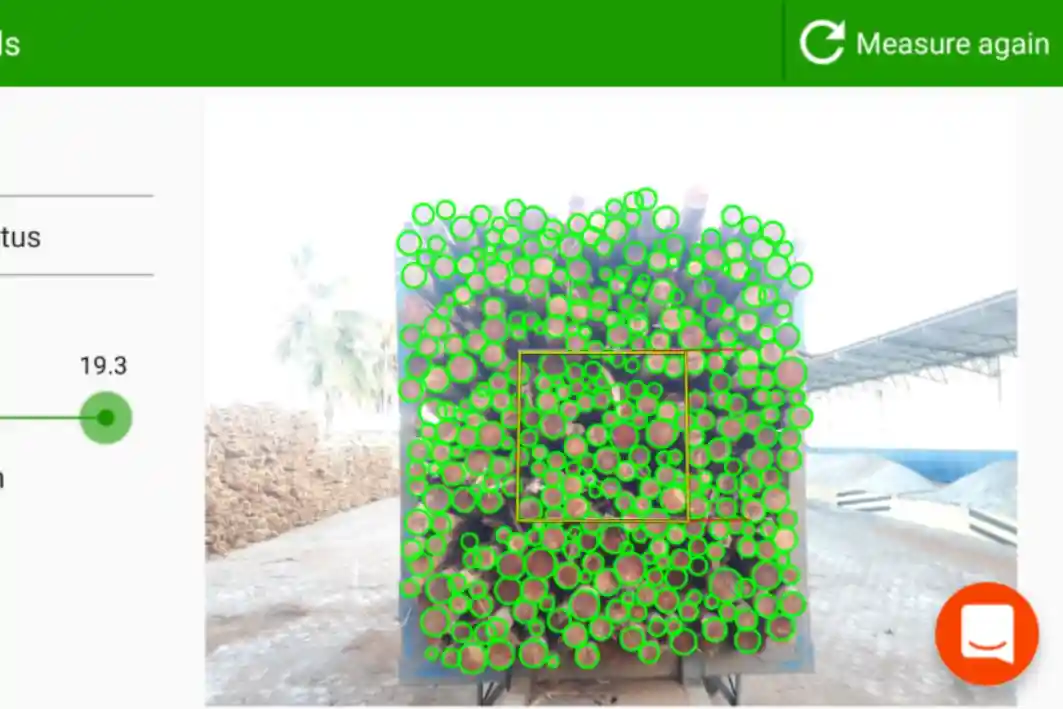Over the past few years, we have noticed an increasing need from various sectors to make accurate measurements of fuel wood in their operations. The pulp and paper industry and sawmills are not the only ones benefiting from using Timbeter to bring efficiency to their supply chain, but other sectors such as the steel industry, food production, consumer goods, chemicals, and others that use fuel wood as an essential part of production, can have extra benefits when using an accurate tool to measure volumes used in their operations, saving time, raw materials and capital.
How is fuel wood measured?
Currently, two types of measurements are the most common for fuel wood: weight and volume. Weight measurements take place on specialized scales and end up not taking into account the humidity of the wood exposed to climatic agents, which is an important factor for the quality of the product.
Regarding the volume measurements, it can be done in two ways: measurement in stéres and measurement in cubic meters, usually together. The fuel wood is stored and placed in piles and then measured with the aid of a meter* to determine its height, width and volume. This measurement considers the amount of wood together with the bark and air.
After this process, a coefficient can be applied to the pile to determine the actual amount of wood in cubic meters. The cubication factor is used to eliminate empty spaces and unusable materials in the pile and generate the real volume that can be taken to the furnaces.
How to make different types of fuel wood measurements with Timbeter
Stére volume
To measure a wood pile in its stére volume is really simple. After placing a physical reference** parallel to the pile, take a picture of the whole pile using the Timbeter and choose the “Pile” function. In the “Density” field, enter the value of 100%, which is the value for measurements that consider air and bark together with the wood logs. This type of measurement will have the gross result in stéres.

Density
To measure the density coefficient (wood without air and bark) of the pile, take a picture of it with Timbeter and choose the “Density” function. You can choose between the coefficient of the whole pile or just part of it. The result will be a decimal value, which will show the amount of wood without air and without bark in proportion to an integer.

Here, we can see that the density of the pile is 0.5802, which means that, when measuring 100% of the pile, 58% of the pile is made of wood without air and bark. When using a physical reference in this type of measurement, the cubic volume will also be available, further facilitating the work of measuring the fuel wood.
Applying the coefficient to determine the cubic volume
If desired, after measuring the density, the user can apply the density coefficient in the “Pile” functionality. After the initial density result, it is necessary to use a percentage in the density field, as explained above (0.5802 in 58%). Take a picture of the pile using a physical reference, select the “Pile” function and enter the necessary data. In a few clicks, the result of the cubic volume will be ready and ready to be shared. It will also be available on the Web Storage Module, the Timbeter platform in the cloud for reporting, inventories and real-time analysis.


How does Timbeter make fuel wood measurements even more efficient?
There is a demand for modernization and digital transformation of operations in sectors of high production, and the very subjective manual measurement of fuel wood can be easily digitized using Timbeter. When using Timbeter, employees will have access to digital measurements made by the mobile application and a real-time overview of the volumes stored through the Web Storage Module.
In addition, both the stére volume and the measurement of the pile density coefficient and cubic volume can be measured with Timbeter in a few clicks, avoiding human error, increasing productivity, profit and saving time. These types of combined measurements, carried out with artificial intelligence and machine-learning bring objectivity and individual values to the fuel wood piles.
Do you need to measure fuel wood in your company and want to save time, have more efficiency and profitability in your operations? Get in touch with our team at info@timbeter.com and start a pilot with Timbeter. Our team offers different types of consultation and trainings to help your team to get started with digital measurements.
*meter: instrument with markings for area delimitation, measuring tape
**physical reference: measuring tape or stick with at least 1 meter long to define the proportion on Timbeter’s mobile application
